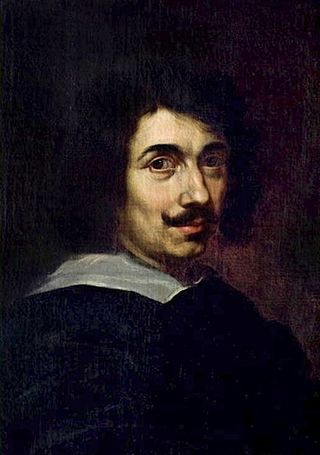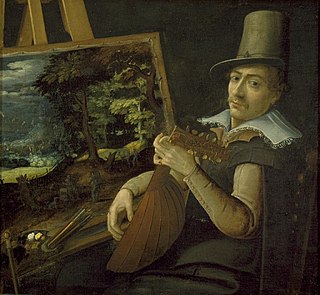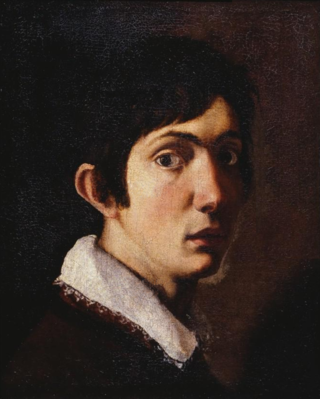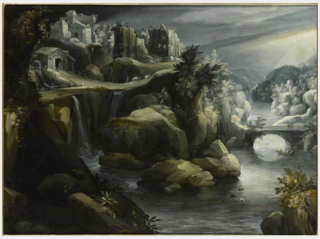
Jan Brueghelthe Elder was a Flemish painter and draughtsman. He was the son of the eminent Flemish Renaissance painter Pieter Bruegel the Elder. A close friend and frequent collaborator with Peter Paul Rubens, the two artists were the leading Flemish painters in the first three decades of the 17th century.

Claude Lorrain was a French painter, draughtsman and etcher of the Baroque era. He spent most of his life in Italy, and is one of the earliest important artists, apart from his contemporaries in Dutch Golden Age painting, to concentrate on landscape painting. His landscapes are usually turned into the more prestigious genre of history paintings by the addition of a few small figures, typically representing a scene from the Bible or classical mythology.
Michiel Coxie the Elder, Michiel Coxcie the Elder or Michiel van Coxcie, Latinised name Coxius, was a Flemish painter of altarpieces and portraits, a draughtsman and a designer of stained-glass windows, tapestries and prints. He worked for patrons in the principal cities of Flanders. He became the court painter to successively Emperor Charles V and King Philip II of Spain.

Paul Bril was a Flemish painter and printmaker principally known for his landscapes. He spent most of his active career in Rome. His Italianate landscapes had a major influence on landscape painting in Italy and Northern Europe.

Baldassare Franceschini, called Il Volterrano after his birth place Volterra and, to distinguish him from Ricciarelli, Il Volterrano Giuniore was an Italian late Baroque painter and draughtsman active principally around Florence and Volterra. He was mainly known for his frescoes, altarpieces and easel paintings for churches and palaces in Florence, Volterra and Rome. His subject matter was diverse and included portraits, biblical and mythological scenes, history paintings and allegorical compositions.

Francesco Furini was an Italian Baroque painter of Florence, noted for his sensual sfumato style in paintings of both secular and religious subjects.

Viviano Codazzi was an Italian architectural painter who was active during the Baroque period. He is known for his architectural paintings, capricci, compositions with ruins, and some vedute. He worked in Naples and Rome. He is known in older sources as Viviano Codagora or il Codagora.

François de Nomé was a French painter of the Baroque period, active mainly in Naples.

Antonio Tempesta, also called il Tempestino, was an Italian painter and engraver, whose art acted as a point of connection between Baroque Rome and the culture of Antwerp. Much of his work depicts major battles and historical figures.

Filippo Napoletano, whose real name was Filippo Teodoro di Liagno was an Italian artist, with a varied output, mainly landscape and genre scenes and also drawings or etchings of diverse, often particular, items such as exotic soldiers, skeletons of animals, or cityscapes.

Filippo Lauri was an Italian painter of the Baroque period, active mainly in Rome.

Angelo Caroselli or Carosèlli was an Italian painter of the Baroque period, active mainly in his native Rome. He created religious works, allegories, portraits as well as genre scenes in the vein of the Caravaggisti. He also returned regularly to scenes of witchcraft and sorcery. His style is eclectic style and shows influences principally from Caravaggio and the painters of 'low-life' scenes active in Rome called the Bamboccianti. His work is characterised by its search for originality. This is demonstrated in the potent naturalism and chiaroscuro that characterise his compositions and his preference for depicting colorful characters of contemporary Rome and scenes of witchcraft and musicians. The work of Caroselli was influential on other Caravaggisti such as the Lucchese painter Pietro Paolini and the Dutch painter Dirck van Baburen.

Pieter van Bloemen, also known as Standaart, first name also spelled Peter or Peeter, was a Flemish painter, draughtsman and printmaker. He was a gifted landscape and animal artist and was very successful with his compositions depicting Italian landscapes with figures, equestrian battles, animals and genre and market scenes.
Events from the year 1635 in art.
Francesco Lauri (1610–1635) was an Italian painter of the Baroque period, active mainly in Rome, but also throughout other parts of eastern and northern Italy and some of France, Spain and Greece.

Marten Ryckaert or Maerten Ryckaert, was a Flemish landscape painter. He was known for his small, usually imaginary landscapes in an Italianate style.

Jan Wildens was a Flemish painter and draughtsman specializing in landscapes. His Realist landscapes show an eye for detail and have a serene character. He was a regular collaborator with Rubens and other leading Flemish Baroque painters of his generation in whose compositions he painted the landscapes.

Vincenzo Campi was a 16th-century Italian painter working in Cremona during the Late Renaissance. Campi is best known as one of the first northern Italian artists to work in the Flemish style of realist genre painting.

Willem or Guiliam van Nieulandt, sometimes Nieuwelandt (1584–1635) was a Dutch Golden Age painter, engraver, poet and playwright from Antwerp.

Matthijs Bril or Matthijs Bril the Younger was a Flemish painter and draughtsman of landscapes. He spent most of his active career in Rome where his drawings of ancient Roman sites played an important role in the development of topographical landscape art. He was also a painter of capricci, with typical rustic hills with a few ruins. He died young and his younger brother Paul Bril, who had joined him in Rome, finished his commissions.




















